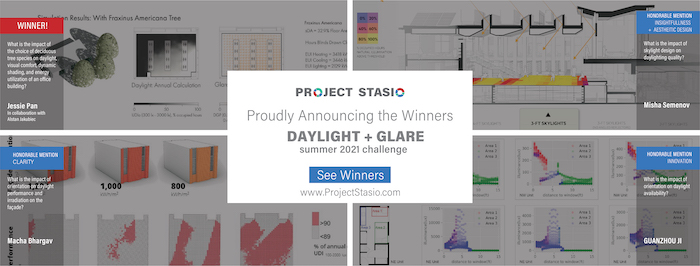
The Project StaSIO team is proud to announce the winners of the 2021 Summer Challenge! The challenge was focused on Daylight and Glare. Big thanks to our Challenge jurors, Christopher Meek and Nicole Peterson. Stay tuned for the upcoming winter 2021 challenge focused on “Simple Box Modeling!”
And the winners are…
WINNER:

“I entered the summer challenge to present the research that I have conducted with Professor Alstan Jakubiec in an easily understandable way, bringing light to the impacts that dynamic landscaping can have on the daylight and energy use of a building,” said Jessie Pan about why she entered the contest. “In our research, we describe a new way of creating detailed, seasonally varying, tree models and applying them within high performance daylight and energy simulations where it was found that a simple design choice of a tree species can have complex simulation needs and variable outcomes.”
She added: “We chose this topic as the interaction between dynamic landscape elements and building performance is not typically considered in sustainable architectural design and building performance simulations. Trees in the urban setting are important as they produce many environmental, social, and psychological benefits while they also positively impact glare, reduce shade use, and lower energy consumption. In current simulation practices, there has not been a standard for tree models, where we propose a holistic tree model that integrates temporal schedules of leaf growth, colour change, and leaf drop, thus resulting in a more realistic simulation result.”
HONORABLE MENTION FOR INSIGHTFULNESS AND AESTHETIC DESIGN:
What is the impact of skylight design on daylighting quality?
“Daylighting is fundamental to human health and to a connection with time and place,” said Misha Semenov about why he chose this topic. “In our designs, Centerbrook strives to create biophilic experiences through carefully tuned lighting, and recently we have been testing powerful tools for quantifying this, such as Ladybug, cove.tool, and the Velux Daylight Visualizer. We are particularly proud of this library “living room” and are excited to share the results of our daylighting study with others.”
On why he entered the contest: “Here at Centerbrook Architects, we are working hard on creating visualizations of energy modeling for our clients and fellow designers to better understand how we make sustainability-minded, evidence-based decisions. Diagrams, as powerful storytelling devices, can be just as much a part of the design deliverables as the building itself. We were really excited for this opportunity to share one of our analysis diagrams, and to see what other people struggling through similar challenges have come up with!”
HONORABLE MENTION FOR CLARITY:
What is the impact of orientation on daylight performance and irradiation on the façade?
“In a hot and dry climate such as Ahmedabad’s, daylight design can be challenging due to the conflict in trying to minimize incident solar radiation on the facade,” said Macha Bhargav about his chosen topic. “Through the graphic, I attempted to answer the question: ‘What is the impact of orientation on daylight performance and irradiation on the façade?’ Orientation optimization was found to impact both daylight performance and irradiation in a desirable manner and thus appears like a conducive design strategy in a hot and dry climate.”
He said he entered the contest because the “Master’s program in Building Energy Performance at CEPT University, India, has integrated this competition as part of the course work, led by Prof. Minu Agarwal. This competition brief is in line with the ongoing semester’s studio titled ‘Lighting, Daylighting, and Integrated Design Lab’ where the major areas of focus are lighting and glare.”
HONORABLE MENTION FOR INNOVATION:
What is the impact of orientation on daylight availability?
“I am currently a second-year PhD student at Carnegie Mellon University, School of Architecture and a researcher at the Center of Building Performance and Diagnostics. I am interested in building science and technology, computational design, and data visualization. I have always been interested in how effective visualization of simulation data can aid designers and building scientists communicate more effectively,” said Guanzhou Ji about entering the contest. “Project StaSIO focuses on this important topic and creates a platform for researchers to share their ideas, which is why I believe it was a great contest for me to enter and I am thrilled to have been selected as a runner-up.”








